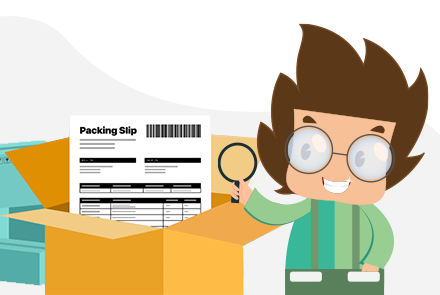What Are Packing Slips and Why Are They Important?
Inventory Management
LAST UPDATE: MAR 13, 2023
5 minutes reading
When customers open their products, many might throw away the packing slips. Nevertheless, many e-commerce enterprises across a wide range of industries depend on these documents. Packaging slips provide a wealth of information that businesses and consumers may use to assess what is inside a package, minimizing errors during packing and enhancing buyer-seller communication.
What Is a Packing Slip?
A packing slip is a piece of paper that is frequently enclosed with a shipment and gives an itemized inventory of the items inside. A packing slip is an inventory packing list that warehouse staff and consumers can use to determine what should go in a box.
Packing slips are frequently printed on plain sheets of paper and placed inside the box with the ordered goods. Packing slips may provide details for a single order or a batch, depending on the order at hand.
What is Packing Slip Used For?
In the majority of e-commerce operations, these pieces of paper are essential. Packing slips are used at almost every stage of the shipping process:
1. Product Selection
To guarantee that the right things are placed in the package, the shipping department produces packing slips as the products are being picked. One of the greatest order picking techniques for warehouses is the barcode pick and pack approach, which employs packing slips to sort selected items into the appropriate boxes for order fulfillment.
2. Ordering Confirmation
For order confirmation, the receiving department employs packing slips. Before preparing the product for shipping, workers will compare the contents of the box to the packing slip to look for discrepancies.
3. Company Owners
Business owners can apply the proper shipping costs by using the information on packing slips to tell them of the descriptions of the contents in the box.
4. Handling Shippers
Shipping operators can avoid damaging the contents of a shipment by following the instructions on the packing papers.
5. Customers
Customers can check the packing slip to make sure their order was accurate once a package has been delivered.
How To Make a Packing Slip
Several types of information are included on packing slips to aid firms in effectively packing orders. Although the specific specifications on a packing slip vary between businesses and goods, you’ll often find the following information there:
- Purchaser and Order Details
- List of the Package’s Contents
- Sizes of the Products
- Object Weight
- UPC or SKU
1. Purchaser and Order Details
The following information is included on packing slips regarding the buyer and the order:
- Name and shipping address of the buyer
- Date of the order
- Contact details for the buyer
2. List of the Package’s Contents
Packing slips include a list of the items in the order, their types, descriptions, and other information like color and design. A list of the items transported individually could be found on the packing slip as well.
3. Sizes of the Products
Multiple items of the same kind may be purchased by customers. In this instance, the packing slip is kept to one page by listing the quantities next to each item. Employees of the warehouse can refer to the quantity of each product category when they are packing boxes for shipping.
4. Object Weight
The general measurements and weight of the items inside the box are noted on the packing papers. Businesses can determine the appropriate shipping charges by using the package’s weight.
5. UPC or SKU
Utilizing the distinctive identification codes issued to each product, businesses control their inventory. These codes could be quick response (QR) codes, universal product codes (UPCs), or stock-keeping unit (SKU) numbers. To aid in inventory control, several e-commerce companies print barcode labels on their packing slips.
The Difference Between a Packing Slip and An Invoice
Although packing slips and shipping labels are two distinct papers with different functions, warehouse employees may mistake them. The two kinds of documents differ in the following ways:
intended purpose: Packing labels inform customers of the contents of a box and instruct warehouse staff as to which products belong in a certain order. The primary function of a shipping label is in shipping, where carriers use them to track and send items. Additionally, companies utilize shipping labels for inventory control.
Location: To ensure that carriers can read and scan the information, businesses always place shipping labels on the outside of the goods. In contrast, the boxes are sealed with packing slips.
Information: The buyer’s name and address, the package’s weight, and the company name and address are all included in both types of documentation. Shipping labels, on the other hand, just list the shipping date, priority, and delivery instructions rather than information on the items in the order.
The Difference Between a Packing and Shipping Label?
Although packing slips and shipping labels are two distinct papers with different functions, warehouse employees may mistake them. The two kinds of documents differ in the following ways:
Intended purpose: packing labels is to inform customers about the contents of a shipment and lead warehouse personnel to the proper items in an order.
The primary function of a shipping label is in shipping, where carriers use them to track and send items. Additionally, companies utilize shipping labels for inventory control.
Location: To ensure that carriers can read and scan the information, businesses always place shipping labels on the outside of the goods. In contrast, the boxes are sealed with packing slips.
Information: The buyer’s name and address, the package’s weight, and the company name and address are all included in both types of documentation. Shipping labels, on the other hand, just list the shipping date, priority, and delivery instructions rather than information on the items in the order.
The Bottom Line
No matter how you complete orders, the packing slip is a useful tool for controlling consumer expectations. Customers will evaluate their experience based on more than just whether everything they ordered has arrived.





Recent Comments